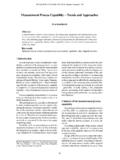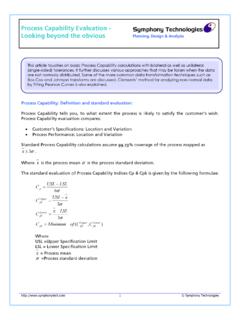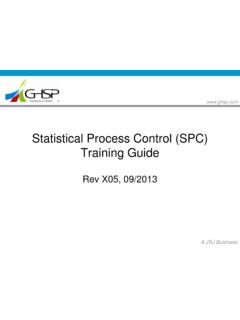Transcription of Process capability indices - Datalyzer-spectrum …
1 capability indices Cp, Cpk, Pp and Ppk Marc Schaeffers 2 1 Introduction An important part of any SPC implementation is the use of Process capability indices . There are several capability indices Cp, Cpk, Ppk, Cpm, NCpk. In this article we will discuss the most common used indices Cp, Cpk, Pp and Ppk. There is quit some confusion about the use of these indices . In this white paper we will try and remove some of the confusion and explain the differences between the indices and how they can be used in a practical way. In chapter 2 we will provide the definitions of the indices and give some historic insight in the development of these indices which will explain some of the confusion.
2 Chapter 3 will explain how the indices can be used in a practical way 2 Definition of indices History What is important to know before we will explain the definitions of the indices is that the definitions in the past have changed. Ppk was defined under the Q101 system of Ford as the preliminary capability index and the Cpk was defined as the long term capability index. In some cases the Cpk value on the histogram was calculated differently from the Cpk calculations on the control chart. When the big three (Ford , GM and Chrysler) merged their quality manuals into the QS9000 system the definitions where changed and these definitions are still the standard nowadays in the TS16949 manual and will be used and explained in this article.
3 Cp Cp (sometimes also named Cpi) stands for the capability index of the Process . The formula for the calculation is: CpUSLLSL= 6 The refers to the estimated standard deviation. The estimated standard deviation is calculated using the following formula: 2/ dR= where Ris the average range of subgroups and 2d is taken from a statistical table. 3 In normal words it means the Cp index is calculated based on the within subgroup variation. So if the variation within the subgroup is very small you will have a good Cp index no matter how much the Process average is drifting or what the location of the Process is so the Cp index shows you how capable your machine is to produce consecutive products within the required variation (Tolerance).
4 Cpk Because the Cp index alone doesn t indicate if you are producing within specifications we need an indication of the Process is centered between the specification limits. Therefore the Cpk index is used. The formula is: )3,3min( = LSLXXUSLCpk So if the Process is exactly in the middle of LSL and USL the Cp and Cpk index are the same. If we now report both Cp and Cpk index we know how capable the Process is to produce within the required variation (tolerance) and if the Process is producing in the middle of the tolerance. Pp Is the information about Cp and Cpk enough to indicate if the Process is running within specifications. The answer is no because these 2 indices are calculated based on the within subgroup variation and it is still possible there is a large amount of between subgroup variation which is not taken into account.
5 Let me try to explain this with an example. 4 Figure 1: Example Launcher Process from DataLyzer SPC Wizard simulation DataLyzer SPC Wizard simulation software was used to generate Process data with the required variation to demonstrate the concept. The Process is a tennis ball launcher which fires balls that bounce once and then land on a target scale. The chart in figure 1 shows the launcher Process where we had a lot of variation between subgroups (Xbar chart) but the variation with the subgroup was in control (Range chart) The Cp index for this Process is and the Cpk index for this Process is which indicate the Process is capable to produce within the required variation and over the reported time period this Process is in the middle of the tolerance.
6 We see that these 2 indices are not enough and we need more information to know if the Process is producing within specification limits. If we only use Cp and Cpk we need to add the requirement that the Process must be in control. If the average chart is in control it indicates the Process is stable and the Process average is not fluctuating. However we don t always have the chart available when analyzing Process data for example if we report a large number of characteristics. In that case we could indicate the percentage of subgroups out of control but there is also another possibility. We can also know if the Process is stable by calculating the Process Performance Index Pp.
7 The Pp index is calculated in the same way as the Cp index but now using the real standard deviation instead of the estimated standard deviation. So the formula is: 5 6 LSLUSLPp = So the Pp index uses both within subgroup variation and between subgroup variation in the calculation and indicates how well the Process was capable to produce within specification limits over the reported time period. The Ppk index is calculated in a similar way as the Cpk index and needs no further explanation. 3 Practical use of capability indices If we now report 3 indices eg Cp, Cpk and Ppk we know what is happening in the Process . Cp indicates how well a Process is capable to produce consecutive products within the required variation.
8 The difference between Cp and Cpk indicates if the Process is producing in the middle of the tolerance. The difference between Cpk and Ppk indicates if the Process is stable or in other words if there are special causes of variation which are influencing the average of the Process even if control limits are not properly set. The requirement in industry is that the Ppk value should exceed If the Ppk value is below the combination of Cp, Cpk and Ppk will give you an indication who is responsible to improve the capability . Let me explain with an example: Ppk = Cpk = Cp = Ppk = Cpk = Cp = Ppk = Cpk = Cp = 6 Figure 2: Three processes with a bad Ppk index All 3 processes have the same Ppk index of but require a completely different approach to improve capability and likely also a different department will be responsible to improve the capability .
9 Process 1: This Process is out of control and has assignable causes. Where possible the Process must be brought in control and primary responsible is production Process 2: This Process has a wrong Process setting and if the Process is brought on target the Ppk will be acceptable. Primary responsible to bring a Process on target is production. Process 3: This Process is not capable to produce consecutive products within the allowed tolerance so this Process needs to be altered. Primary responsible to improve this Process is engineering. Of course the statements above are simplifications and in practical situations it can be different or much more complicated but the general idea is often very helpful.
10 4 General remarks This whitepaper was written to give you some better information on the use of the capability indices Cp, Cpk, Pp and Ppk and the power to use them together to get insight what is going on in the Process . Some specific areas and complications of capability indices are deliberately left out of the document to keep matters clear for SPC novices. When applying this in practice you will encounter special situations which require a little more insight. For example what is the Pp value if you only have one specification limit or what is the Ppk value if you have a lower limit of 0 (eg perpendicularity) and you cannot have values below 0. SPC software packages like SPC Quickie and DataLyzer Spectrum will calculate the capability indices correctly in all these situations For further details or contact us through 5 Further study DataLyzer SPC Wizard has a full training module which helps you to get better understanding of capability indices .








